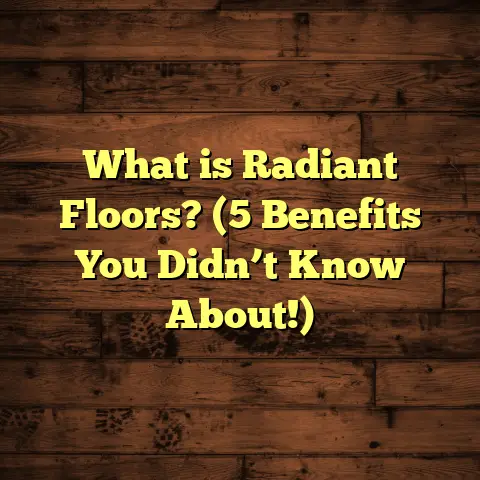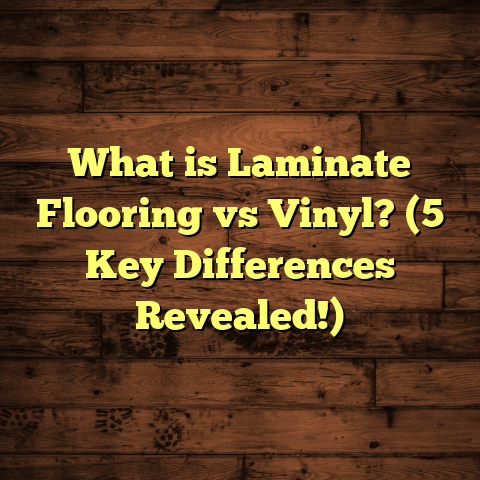What is Terrazzo Floors Made Of? (5 Key Materials Explained)
Upgrading your home often means refreshing the look and feel of your living space. You might paint the walls, swap furniture, or update lighting fixtures. But have you ever stopped to think about the impact your flooring has on the whole vibe of your home? I remember when I first started working with terrazzo floors—there was something about their unique blend of beauty, resilience, and history that really caught my attention. Over time, I’ve come to appreciate terrazzo not just as a flooring option, but as a lifestyle upgrade that adds character and value to any space.
If you’re curious about what terrazzo floors are made from and why they’ve been popular for centuries, stick around. I’ll walk you through the five key materials that make terrazzo what it is and share some insights from my own experience installing and maintaining these floors.
What Is Terrazzo Flooring?
Let’s start with the basics. What exactly is terrazzo flooring?
Terrazzo is a composite material used primarily for floors and walls. It’s made by mixing small pieces of stone, glass, or other aggregates into a binder like cement or resin. Once poured, this mixture is allowed to harden, then ground and polished to create a smooth, durable surface that showcases the embedded materials in a beautiful mosaic-like pattern.
Its origins go way back—Venetian workers invented terrazzo as a clever way to reuse marble scraps around the 15th century. Instead of throwing away leftover bits from marble cutting, they mixed these chips with cement to create a new surface. The result was not only cost-effective but visually striking.
Today, terrazzo is still prized for its decorative appeal and longevity. Unlike some trendy flooring materials that wear out quickly, terrazzo can last for decades—even centuries—with proper care. This makes it ideal for areas with heavy foot traffic like schools, airports, hospitals, and now more and more homes.
The look of terrazzo depends largely on the materials used in its mix—the binder and the aggregates. This combination creates endless design possibilities: from subtle neutral tones to vibrant patterns that act as a focal point in any room.
The 5 Key Materials That Make Terrazzo Floors
I want to break down the five main materials that go into making terrazzo floors. Each plays an essential role in how the final floor looks and performs.
1. The Binder: Cement vs. Resin
The binder is what holds everything together—it’s basically the “glue” for terrazzo.
Cement-Based Binder
Traditionally, terrazzo used a cement-based binder. This is where Portland cement is mixed with water and aggregates to form a slurry that hardens over time.
I’ve worked on many projects using cement-based terrazzo. It’s strong, durable, and well-understood by contractors worldwide. However, it has some downsides:
- Long curing time: Cement terrazzo needs about 28 days to fully cure before polishing can start.
- Less flexibility: Cement floors can crack if the underlying substrate moves or shifts.
- Color limitations: Cement is naturally grayish, which can dull aggregate colors unless pigments are added.
That said, cement-based terrazzo remains popular for outdoor spaces or industrial environments due to its toughness and weather resistance.
Epoxy Resin Binder
More recently, epoxy resin binders have become popular in residential and commercial settings alike. Epoxy is a synthetic polymer that cures quickly and offers several advantages:
- Fast curing: Epoxy terrazzo cures in 24–48 hours, speeding up installation.
- High flexibility: Less prone to cracking because it can flex with substrate movement.
- Wide color range: Since epoxy is transparent, pigments don’t lose vibrancy.
- Smooth finish: Epoxy terrazzo creates a glossy surface that highlights aggregates beautifully.
From my experience, epoxy resin allows for more creative design options and faster project completion. For example, a client recently asked me to install terrazzo in their kitchen with wild colors; epoxy made that possible without sacrificing durability.
| Feature | Cement Binder | Epoxy Resin Binder |
|---|---|---|
| Cure Time | ~28 days | 1–2 days |
| Flexibility | Low | High |
| Color Options | Limited | Extensive |
| Durability | High but brittle | Very high |
| Environmental | More carbon footprint | Less carbon footprint |
From environmental and aesthetic points of view, epoxy often wins—though cement still has its place depending on project needs.
2. Aggregates: The Decorative Chips
The aggregates are the heart of terrazzo’s visual appeal. These are the chips embedded in the binder that create color, texture, and pattern.
Marble Chips
Marble remains the classic choice for terrazzo aggregates. Its natural veining and color variations add sophistication and timelessness.
I’ve installed tons of marble chip terrazzo floors—white marble chips are especially popular for brightening spaces while maintaining an elegant look.
Marble chips typically range in size from 1/8 inch up to 3/8 inch. Larger chips create bold patterns but may feel rough underfoot; smaller chips give a smoother finish but subtler aesthetics.
The percentage of marble chips can range from 25% up to 50% by volume in the terrazzo mix. Higher aggregate content means more color but can make polishing more challenging.
Other Stone Aggregates
While marble dominates, other stones like granite or quartz are sometimes used for different textures or colors:
- Granite: Offers speckled patterns and high hardness.
- Quartz: Adds sparkle and durability.
- Travertine: Provides warm earth tones with natural pits and textures.
Using multiple stone types lets designers create one-of-a-kind terrazzo floors tailored to specific tastes.
Glass Aggregates
Glass chips add an extra layer of shine and color vibrancy. They come in recycled varieties too, making them eco-friendly.
For instance, I once worked on an art gallery floor using recycled blue and green glass aggregates combined with clear epoxy binder. The result was like walking on a shimmering riverbed—visually stunning and sustainable.
Glass aggregates typically make up 10–30% of the total mix volume.
Specialty Aggregates
Sometimes installers incorporate unique materials like mother-of-pearl, metal flakes, or even semi-precious stones for high-end projects or artistic installations.
One memorable project involved embedding copper flakes into terrazzo for a warm metallic sheen that complimented rustic wood interiors perfectly.
3. Sand or Filler: The Supporting Cast
To fill gaps between larger aggregates and support structural integrity, fine sand or powdered fillers are added to the mix.
Types of Fillers
- Silica sand: Commonly used with cement binders because it bonds well.
- Marble dust or limestone powder: Used mostly with epoxy binders to improve texture and polishability.
- Other mineral powders: Sometimes blended in for specific performance enhancements.
Adding filler helps level out the surface so it’s not overly rough while keeping it dense enough for polishing.
Why Fillers Matter
The right filler amount improves strength without compromising appearance. Too little filler means uneven surfaces; too much makes grinding tricky and can weaken the floor.
On one project where filler ratios were off, I noticed tiny voids after polishing—something you want to avoid because it affects aesthetics and durability.
4. Pigments: Adding Color Beyond Natural Stone
Pigments tint the binder itself to create solid or translucent background colors beneath the aggregates.
I love using pigments because they open up endless design possibilities. Whether you want soft pastels or deep jewel tones, pigments let you customize terrazzo floors beyond natural stone hues.
How Pigments Work
Pigments are mixed directly into cement or epoxy binders before pouring. The concentration controls how intense the color appears.
For example:
- Low pigment concentration produces subtle pastel shades.
- Higher pigment levels yield rich, saturated colors.
Popular Pigment Colors
Some favorite pigment choices include:
- White: Brightens rooms without overpowering aggregate colors.
- Black: Creates dramatic contrast.
- Blue and Green: Evoke calm, natural vibes.
- Red and Yellow: Add warmth and energy.
In one home theater project, I used dark gray pigment with white marble chips for a sleek modern look that hides dirt well—a practical plus for high-use areas.
5. Sealers & Finishes: Protection & Shine
After pouring, curing, grinding, and polishing terrazzo floors come sealers and finishes that protect the surface from wear while enhancing appearance.
What Sealers Do
Sealants:
- Prevent water penetration.
- Resist stains from spills.
- Add slip resistance.
- Enhance shine or matte finish depending on preference.
I always advise clients to apply high-quality sealers after installation and reapply every 1–3 years depending on foot traffic levels.
Types of Sealers
- Penetrating sealers: Absorb into pores without changing surface texture; good for natural stone look.
- Surface sealers: Form a protective coating; provide gloss or matte finishes.
- Anti-slip treatments: Added where safety is a concern (bathrooms/kitchens).
In commercial buildings I’ve worked on, regular sealing helped extend floor life by decades—saving money on repairs or replacements down the line.
Helpful Tips From My Experience Installing Terrazzo Floors
Since I’ve worked on everything from small residential kitchens to large commercial airports with terrazzo flooring, here are some tips I’d share if you’re thinking about getting this kind of floor:
Choose Your Binder Wisely
Ask your contractor what type of binder they plan to use—and why. Epoxy resin costs more initially but cures faster and offers more color options. Cement is cheaper but takes longer and can crack if not installed properly.
If you’re remodeling an indoor space where time is tight or you want bright colors, epoxy might be the better bet.
Think About Aggregate Size & Color
Aggregates affect both look and feel underfoot. Larger chips create bold patterns but aren’t very smooth barefoot; smaller chips feel softer but subtler visually.
Mixing different sizes adds dimension but requires skillful polishing to avoid unevenness.
Color combinations make all the difference too—don’t hesitate to ask for samples before committing.
Invest In Professional Polishing
Grinding and polishing bring out terrazzo’s signature shine but require specialized equipment and experience. DIY attempts rarely match professional results.
Skip this step or do it poorly, and your floor won’t have that smooth glassy finish that makes terrazzo so distinctive.
Plan For Maintenance
While terrazzo is tough, it’s not indestructible. Regular cleaning with pH-neutral products keeps stains away without damaging sealers.
Avoid harsh chemicals or abrasive tools that could dull the surface over time.
Applying sealer every few years maintains water resistance and keeps floors looking new longer.
Consider Environmental Impact
Using recycled glass aggregates or eco-friendly epoxy binders can reduce your project’s carbon footprint significantly.
I’ve seen many clients appreciate knowing their beautiful floor also supports sustainability goals—especially relevant in today’s green-building conscious market.
Interesting Data Points & Industry Insights
Here are some facts based on research combined with my hands-on experience:
- Terrazzo floors can last anywhere between 40 to over 100 years if properly maintained.
- Installation costs vary widely: $20–$100 per square foot depending on materials chosen (cement vs epoxy), aggregate type, pattern complexity, and labor fees.
- Epoxy-based terrazzo systems cut installation time drastically—from nearly a month (cement) down to just a few days.
- Aggregate content usually falls between 25%–50% of total volume by weight—higher percentages produce more colorful but harder-to-polish surfaces.
- Sealers need reapplication every 1–3 years; neglecting this reduces stain resistance noticeably.
- Recycled glass aggregates reduce environmental impact by keeping waste out of landfills—an important factor as green building trends grow.
A Case Study From My Recent Work
A few months ago I installed a terrazzo floor for a family home’s open-plan living room and kitchen area. They wanted something durable yet artistic—something that would stand out but still feel warm and inviting underfoot.
We decided on an epoxy resin base mixed with white marble chips paired with shades of green recycled glass aggregates scattered throughout. The epoxy binder allowed us to add soft green pigments matching their décor palette while keeping curing times short so they could move back quickly.
Once polished to perfection, light bounced off the floor beautifully without glare—brightening up the space during daytime naturally. The clients loved how easy it was to clean too; spills wiped away effortlessly without staining thanks to a premium sealer layer applied after installation.
Six months later? The floor still looks flawless despite daily foot traffic from kids and pets—a testament to terrazzo’s durability when installed properly.
Wrapping It Up
Terrazzo flooring isn’t just about aesthetics—it’s about combining art with engineering for a lasting upgrade to your home or business environment. Understanding what goes into making these floors helps make smarter choices when planning your flooring project—and lets you appreciate why terrazzo remains popular centuries after its invention.
If you want something unique that offers both style and substance, terrazzo deserves serious consideration. From binders to aggregates, fillers to pigments and sealers—each component matters in shaping your floor’s look and lifespan.
Feel free to reach out if you have questions about installing or maintaining terrazzo floors—I’m happy to share more stories and advice based on years of hands-on experience!
This comprehensive guide should give you all you need to know about what goes into making terrazzo floors special—from raw materials through installation tips. Ready to explore this beautiful option? Your floor could be next-level stunning before you know it!





